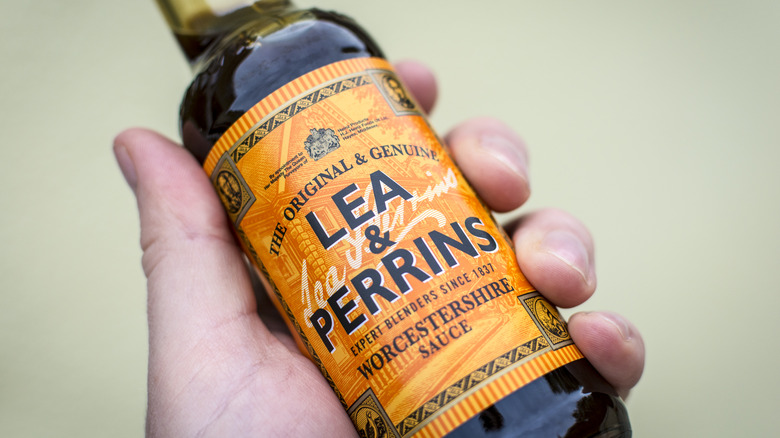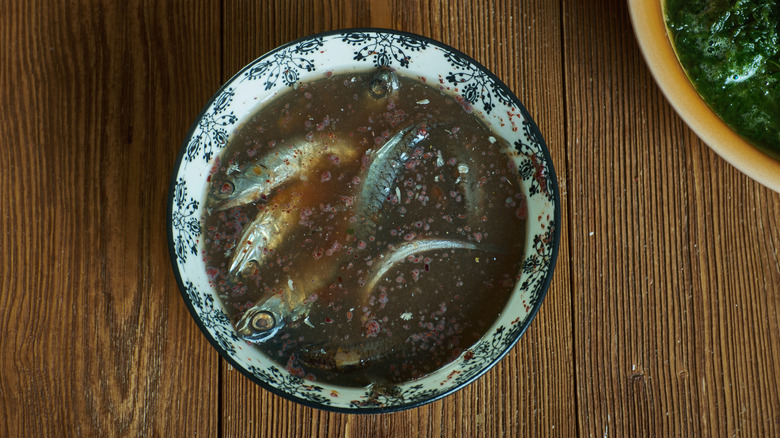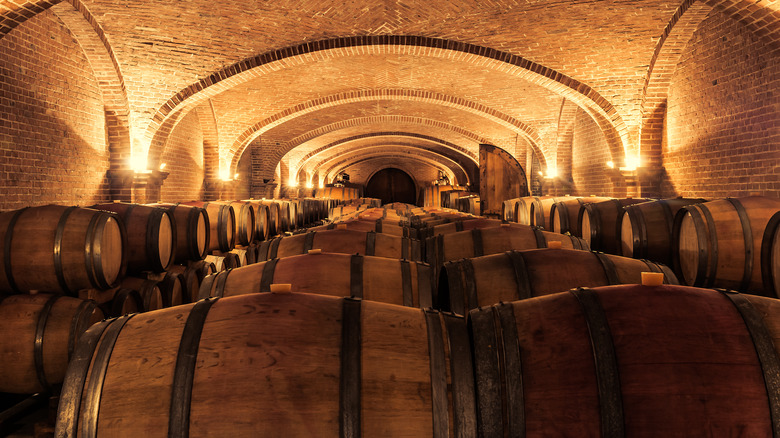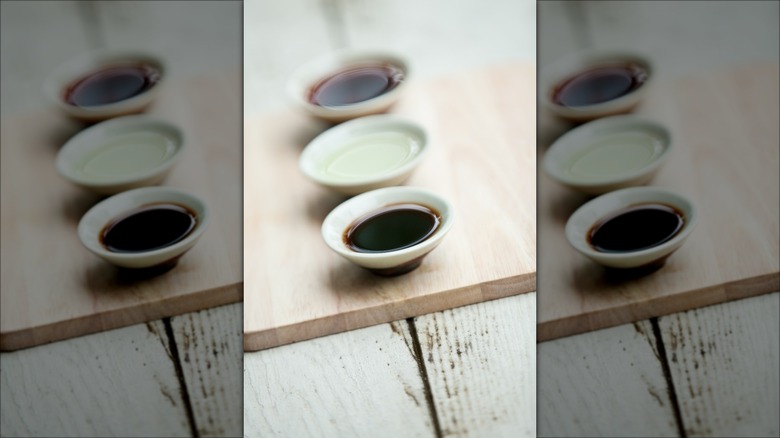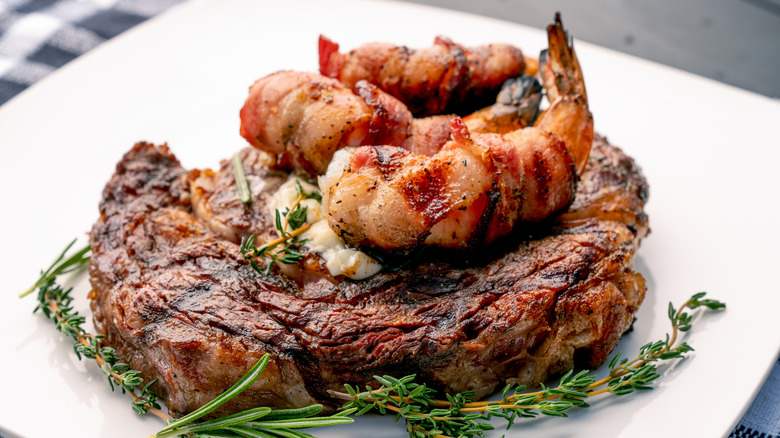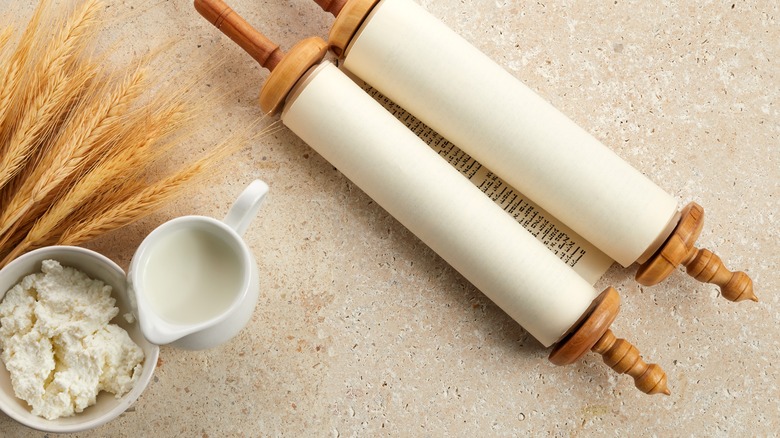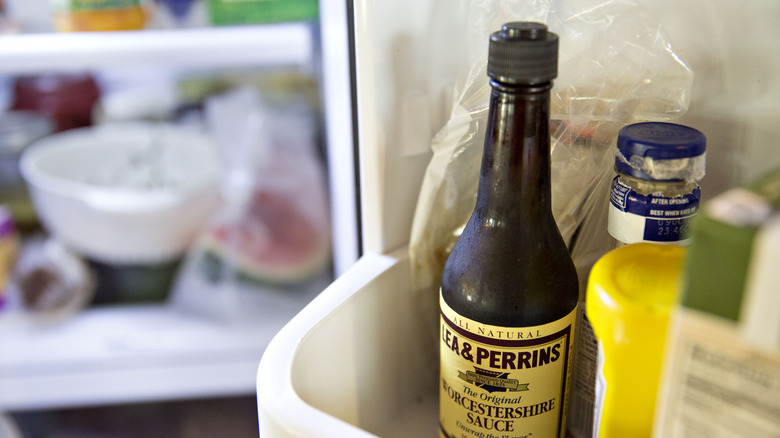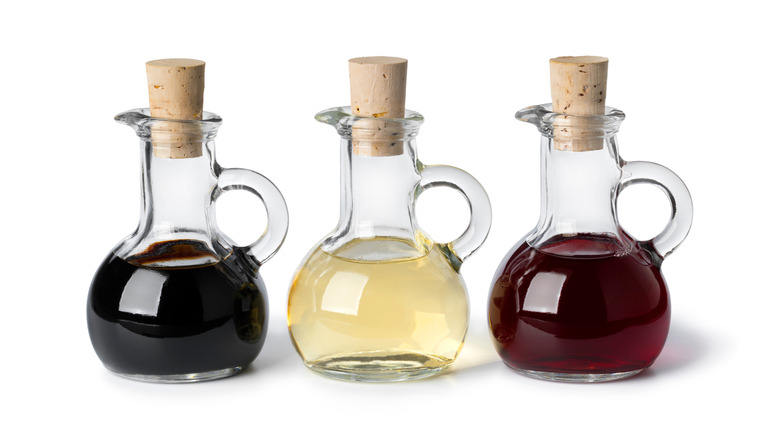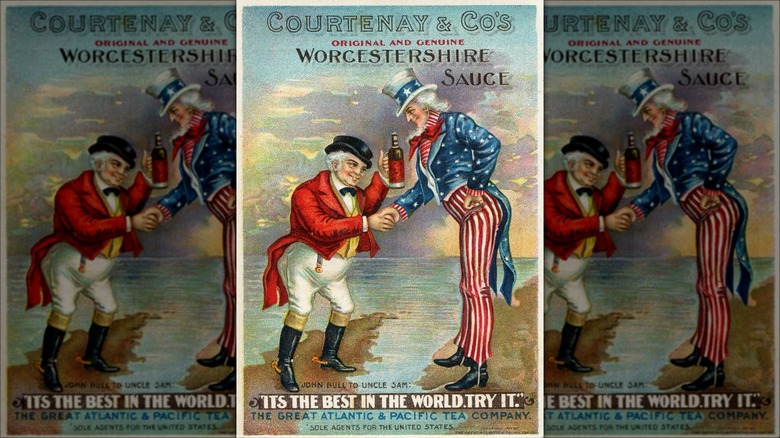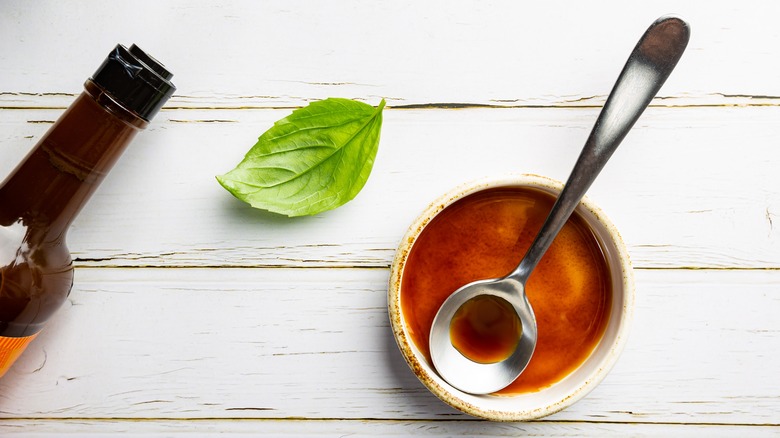What Is Worcestershire Sauce And Why Does Everyone Love It So Much?
When most people joke about their food being chemistry experiments, it is unlikely that they expect said experiment to turn into a multi-billion-dollar vat of gold that makes steak dinners on cruise ships the highlight of the trip. But then again, most people's chemistry experiments don't become Worcestershire sauce. Such is the legacy of Lea & Perrins Worcestershire sauce. When two chemists, John Wheeley Lea and William Henry Perrins, set out to create an Indian fish sauce knock-off for Lord Marcus Sandys, they probably had no idea that their almost-failed chemistry experiment would very shortly inspire them to leave the pharmacy business altogether and embark on a culinary journey that would eventually see the modern iteration of their company be sold to Kraft Heinz in 2005 in a deal worth almost a billion dollars.
Granted, this journey took two centuries, and the original inventors of the condiment didn't live to see the legacy item that their beloved sauce would become. But no matter. They experienced plenty of success in their lifetimes. They also fought with imitators, but few of their imitators had the savvy to combine Lea & Perrins' scientific expertise with the incredible marketing tactics that included serving their concoction to a captive audience that made it a popular vacation souvenir of its day. In the process, Worcestershire sauce's success pointed toward the kind of foodie fanaticism that made people love Worcestershire sauce as much today as they did two hundred years ago when it first came out.
What is Worcestershire sauce?
Worcestershire sauce is a condiment several thousand years in the making. More specifically, it's a condiment flavored with a multitude of seasonings, like molasses, vinegar, and garlic, and with fermented fish sauce — care of anchovies — being a key ingredient. The longer explanation of it is Worcestershire sauce is closely related to the ancient fish sauce garum, which 4th-century Roman gourmand Apicius wrote about in his cookbook. It was a recipe so pungent and unpleasant that ancient laws forbade its production within close proximity to city limits.
The earliest known version of the fish sauce dates back to the ancient Phoenicians and Greeks, and the earliest evidence of it points to it coming into existence in around 500 B.C. The recipe for garum is mostly the stuff of legends now. Its absence left a hole in the proverbial condiment aisle, which Worcestershire sauce now fills, and the modern fish sauce is used in a similar way as its ancient counterpart – that is to flavor everything from steak and chicken to bar drinks and casseroles.
Origins of Worcestershire sauce
The origin story behind Worcestershire sauce reads like something out of science fiction. It's not an exaggeration to say that, unlike SciFi tales like "Frankenstein," it was a science experiment gone right instead of a science experiment gone wrong. Two chemists named John Lea and William Perrins set their minds to creating a fish sauce that originated in Bengal and was a favorite of a friend, who wanted them to replicate his beloved condiment so that he could enjoy it without having to return to Asia where he found it.
Never mind that they were chemists instead of cooks. In 1837, they took it upon themselves to make a sauce from the likes of pickles, sugar, salt, anchovies, soy, cloves, tamarind, water, and vinegar. Their first attempts at the sauce were so nose-pinchingly bad that they left the concoction in the cellar of their pharmacy for nearly two years. It must have been some kind of dare that convinced them to try the concoction after being dormant in the basement for that long.
But as with a good wine, the fermentation process did its magic, and despite its oddball ingredients in the first batch of Worcestershire sauce, the first taste out of the barrel was delicious enough for them to decide to sell the 18-month-old fish sauce to an unsuspecting public.
Product marketing included serving it on ocean liners
If you were to take a cruise aboard a luxury ocean liner in the 19th century, you probably wouldn't expect your souvenir to be a gift-wrapped bottle of Lea & Perrins Worcestershire sauce, but such were the marketing tactics of the condiment's two chemist inventors. The pair also employed door-to-door salesmen and cookbook marketing, too, but the cruise ship marketing proved to be irresistible for would-be Worcestershire sauce consumers.
However, cruise ship marketing turned out to be a brilliant move. All it took was Lea and Perrins to convince stewards on British cruise ships to put the sauce on the table at meal times for passengers to try. It gave the captive audience who could afford first-class dining a chance to try the sauce on everything from seafood to steak. Truly adoring fans could buy a bottle to take home with them once the cruise concluded. It certainly looked the part. Due to bottle fragility, the bottles still had the protective wrap on them, a brand feature that carried over to the time when the condiment made it into stores and made them look like a wrapped gift, which certainly didn't hurt the product's marketing at all.
To make a long story short, it didn't take long for the condiment to become a bonafide hit with foodies. By 1945, a factory earmarked for the creation of the fermented liquid was born.
How do you pronounce it?
Even for people who love Worcestershire sauce, pronouncing the name of it may present a bit of a challenge. If you were to try sounding it out, it should sound something like "war-chest-i-shire" sauce, if you were to consider how the word looks phonetically (and logically). But often, the English language is anything but logical, and so it is with the pronunciation of this Bloody Mary- and steak-enhancing delicacy. Its actual pronunciation is something like "wuu-ste-sher."
Much of the confusion stems from a lack of understanding of the history of the English language. The current pronunciation is influenced by how "Worcestershire" — the county in England the sauce was named after — was pronounced in Old English. Although the spelling has evolved, the way the word is said hasn't evolved as much. It's a bit like the word "Wednesday." It looks like it should be pronounced "wed-ness-day," but it's not. The same rule applies here.
When did it go international?
It only took a decade or so for Worcestershire sauce to go from salvaged chemistry experiment to must-have gourmet meal accoutrement. By 1939, it had made its way to American shores — in the Big Apple, to be exact. It turns out that this ocean liner treat wasn't just a delicacy for seafaring passengers, however. The year 1865 saw the two chemists giving up chemistry. The Worcestershire sauce business proved to be too lucrative to spend much time concocting new potions when their old potion worked out so well for them financially.
Eventually, the appeal of the original Worcestershire sauce spawned other food and drink ideas once it went international. For example, the inspiration for the Bloody Mary came in 1921 after a bartender added some of the sweet and savory sauce to his newly-concocted drink. With that, the savory brown liquid turned into gold, firmly rooting itself into 20th-century foodie life.
How does its taste differ from fish sauce and soy sauce?
Fish sauce, soy sauce, and Worcestershire sauce are all savory brown sauces that foodies put on food and in their drinks to add a bit of umami flavoring to their goodies. Because both Worcestershire sauce and fish sauce contain anchovies, there are some flavor crossovers between the two. That said, Worcestershire sauce tends to have a more complex flavor profile because it has more ingredients than fish sauce. Fish sauce has a salty fish taste, which offers hints as to its origins. It's basically just plain salted and fermented fish. But Worcestershire sauce also has a sweet-and-sour element to it that fish sauce doesn't, making it completely different in many ways from its counterpart.
Soy sauce gets its umami flavoring from fermented soybeans. Worcestershire sauce is also fermented, but it contains fermented seafood products, whereas soy sauce only contains plant-based ingredients. It will lack the sweet and sour profile that Worcestershire sauce has because it contains no ingredients like vinegar and sugar like Lea & Perrins and other brands of Worcestershire sauce do.
Common uses for Worcestershire sauce
From Bloody Marys to surf-n-turf dishes, there are few recipes that don't or can't benefit from a good dose of Worcestershire sauce in large part due to its complex flavor profile. True enough, it has the savory umami flavor that your standard bottle of soy sauce has, but because of the fish content, it definitely can find its way around your seafood, in a manner of speaking. This is partially why it's difficult to find a good vegetarian or vegan Worcestershire sauce, though there are some.
But there's more to it than even those two flavors. Vinegar, garlic, onion, and even molasses infuse the condiment with a sweet and sour taste, plus a certain je ne sais quoi that makes describing the flavor of Worcestershire as challenging as it is to pronounce. That's actually good news. It means that this is the little condiment that could. It's the go-to way to give your Bloody Mary more of a kick. It flavors meatloaf in a way that ketchup alone can't. And as far as steak goes, there's so much to taste when you add a bit of Lea & Perrins to your meat than if you had just opted for your standard steak sauce. If you're a Caesar salad fan, this savory brown liquid's got you covered, too. In short, there's almost no way to use Worcestershire sauce incorrectly, and every reason to try at least a bite of it on your favorite recipes.
Who should avoid it?
Popular as it is, Worcestershire sauce isn't for everyone, and not necessarily because they don't like the taste. Vegans, vegetarians, and those who follow a kosher diet may want to look for alternatives when it comes to doctoring up their food with this umami flavor. For vegans and vegetarians, the inclusion of anchovies in the sauce takes it off the table completely. Fortunately for them, some viable plant-based substitutes now exist on the market. Brands like The Wizards, Whole Foods 365, Annie's Naturals, MontoFresh, and Urban Platter count among those that carry a vegan- and vegetarian-friendly version of Worcestershire sauce. However, when in doubt, it's always good to read the labels because some "regular" versions of Worcestershire sauce aren't made with fish. In many cases, the recipe varies from brand to brand and may not necessarily follow the original recipe created by Lea & Perrins.
Among those who follow a kosher diet, Worcestershire sauce can occasionally be problematic due to its fish content. However, this is conditional. That is to say, while it's fine for them to use the condiment on seafood-based or vegetable-based meals, they must avoid it when eating meat. This includes using it on chicken as well as other types of meat, like lamb or deer. Incidentally, anchovies themselves are considered kosher fish to eat.
Is it shelf stable after opening?
Some people put condiments, like Worcestershire sauce, in the refrigerator after opening as a matter of course. However, this isn't necessary and really only required if the user wants to maintain a fresher taste. It really is a matter of preference, then, whether you choose to put your opened bottle of Worcestershire sauce in the fridge or in the cupboard. This works because the ingredients in the sauce are either fermented or naturally shelf-stable already, allowing for some flexibility in terms of where you store the opened bottle.
If you opt not to refrigerate your Worcestershire sauce after opening, it is advised that you keep it in a cool, dark place, ensuring that the seal is tight and that the bottle stays out of the sunlight. The sauce will keep for six months to several years depending on the brand, and if you consume it on the regular.
There is one caveat to the above statement. If you've done the total home gourmand thing and made your own Worcestershire sauce — good on you, by the way! — you might want to refrigerate your version of the condiment as it won't have the preservatives the store-bought Worcestershire sauce might have.
What to use if you're out of it
Running out of Worcestershire sauce is among the great tragedies of dinner gone wrong, given how versatile the condiment is. If you don't have a backup bottle waiting for you to crack open, you do have some substitution options, though, which you can choose based on what you're making.
If it's an Asian dish you're trying, then soy sauce, of course, is a viable alternative, as is Asian fish sauce. If you're making a dish like meatloaf, ketchup will add some of the flavor that you need. A squirt or two of soy sauce in there as well will give it the umami flavor you crave, while the ketchup adds a bit of the sweet element to it. Steak sauce is an option here, too.
Balsamic vinegar or red wine is a good way to go if you miss some of Worcestershire's tanginess. Both also work as a base for a marinade in case that's one of the major ways you use Worcestershire sauce, though generally speaking, vinegar or red wine add lots of flavor to other cooked dishes, too. Finally, oyster sauce also offers many of the same qualities from a flavor perspective as Worcestershire sauce does, though it tends to be slightly sweeter than its anchovy-based counterpart.
Are there different brands of it?
Given that Lea & Perrins Worcestershire sauce is the granddaddy of all of them, it's tempting to think it's the only brand out there. Leaving brand loyalty discussions aside, it's accurate to say this isn't the case. By as early as 1850, people began using variations of the Worcester or Worcestershire name in relation to the condiment, the first of which came out of New Zealand, highlighting the global status Lea & Perrins' invention had reached. It only took until 1852 for forgeries of the condiment to appear in places like New York. Other less expensive knock-offs, like Phillip's brand, started to advertise by 1866.
Certainly, the Lea & Perrins company did its best to prevent these breaches, but their efforts proved to be in vain. In 1876, Lea & Perrins lost its bid to have the words "Worcestershire sauce" trademarked, allowing any would-be condiment sauce manufacturers to concoct their own steak sauce potions.
Among the notable alternative brands that exist in the 21st century, there's French's (of French's mustard fame) Wan Jan Shan Gluten-Free Worcestershire sauce, Haddar (a kosher-friendly version of the sauce) Bourbon Barrel, Bull-Dog, and Bear & Burton's, which makes both a vegan version and one containing fish. And this list doesn't include the many from-scratch recipes for Worcestershire sauce that exist, nor any of the Worcestershire sauce hacks that make your Lea & Perrins taste even better in practically nothing flat.
Why do people like it?
Worcestershire sauce is an everything-but-the-kitchen-sink kinda condiment, and this feature plays a big role in why people love it so much. To start with, lots of people love its umami flavor, and while it adds the necessary savory perkiness to recipes you would expect, like Bloody Marys, of late, people have also begun adding it to recipes and cuisines that don't normally call for it. Asian cuisine stands out as an example here.
Right off the bat, it competes neck-and-neck with soy sauce as a source of umami flavoring, but it leaves soy sauce in the dust is the additional flavor profiles it adds. It's sweet and sour, making it a viable option as a meat marinade for chicken or beef. Creative Asian cuisine chefs even add more condiments, like oyster sauce, ketchup, and soy sauce, to meat recipes to add a complex flavor profile to lamb and other dishes.
But it isn't just in the Asian recipes realm where Worcestershire sauce shines. A few squirts of this condiment into a roast, shepherd's pie, or gravy is often enough to flavor the whole meal. That is to say because it contains so many different ingredients, including molasses, garlic, and fermented fish, it's rarely necessary to add additional spices to the mix. They're all contained in one bottle of Worcestershire.
